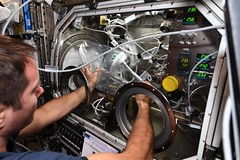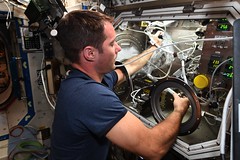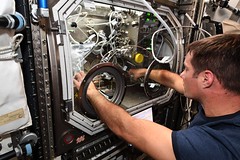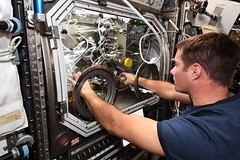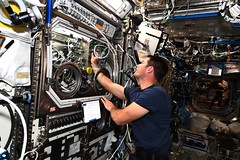Metal
lundi 14 juin 2021 à 13:40Thomas Pesquet posted a photo:
Working on the SUBSA experiment. It stands for "Solidification Using a Baffle in Sealed Ampoules" which doesn't help much to understand what is going on admittedly. We were processing samples of metal alloys for researchers to observe how they are cast. Metallurgy is a hot subject for space research (not only because of the casting temperatures #dadjoke) because how metals form is complicated, very precise, and as metals are used everywhere on Earth improving them could have enormous benefits. As metals form, they grow crystals that resemble Christmas trees, and these crystals influence the strength of the metal. On Earth gravity influences how these crystals grow, so observing the process in space helps to understand the process, making it easier for researchers to create mathematical models. ESA has a facility called the Electromagnetic levitator in the Materials Science Laboratory to conduct research in this same domain. After the bronze age and iron age this type of research could lead to another metal age... :sunglasses: An observant viewer will notice that I am wearing different t-shirts – no I didn't spill any (they are in sealed ampoules remember!) but the experiment runs over many days, actually the Materials Science Laboratory was running similar metal batches in Columbus too!
L’expérience SUBSA sur laquelle j’ai déjà travaillé plusieurs fois (les plus observateurs auront remarqué les t-shirts différents :wink:) : en gros, c’est de la métallurgie spatiale. Les alliages sont un sujet assez chaud pour la recherche spatiale, et pas seulement à cause de leur température de fusion (je ne résiste pas à la blague de papa :smile:). L’amélioration des alliages, omniprésents dans notre vie moderne, a évidemment un potentiel d’applications immense sur terre. Les métaux se forment en poussant comme des cristaux (avec une forme un peu sapin de noël si on a de l’imagination), et ces processus sont fortement influencés par la pesanteur, d’où l’idée d’enlever ce facteur pour mieux les appréhender. Après le bronze et le fer, ces recherches pourraient donner naissance à un nouvel âge du métal :thumbsup:
Credits: ESA/NASA–T. Pesquet
607C7849
